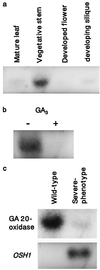Decreased GA1 content caused by the overexpression of OSH1 is accompanied by suppression of GA 20-oxidase gene expression
- PMID: 9701574
- PMCID: PMC34882
- DOI: 10.1104/pp.117.4.1179
Decreased GA1 content caused by the overexpression of OSH1 is accompanied by suppression of GA 20-oxidase gene expression
Abstract
We previously reported that overexpression of the rice homeobox gene OSH1 led to altered morphology and hormone levels in transgenic tobacco (Nicotiana tabacum L.) plants. Among the hormones whose levels were changed, GA1 was dramatically reduced. Here we report the results of our analysis on the regulatory mechanism(s) of OSH1 on GA metabolism. GA53 and GA20, precursors of GA1, were applied separately to transgenic tobacco plants exhibiting severely changed morphology due to overexpression of OSH1. Only treatment with the end product of GA 20-oxidase, GA20, resulted in a striking promotion of stem elongation in transgenic tobacco plants. The internal GA1 and GA20 contents in OSH1-transformed tobacco were dramatically reduced compared with those of wild-type plants, whereas the level of GA19, a mid-product of GA 20-oxidase, was 25% of the wild-type level. We have isolated a cDNA encoding a putative tobacco GA 20-oxidase, which is mainly expressed in vegetative stem tissue. RNA-blot analysis revealed that GA 20-oxidase gene expression was suppressed in stem tissue of OSH1-transformed tobacco plants. Based on these results, we conclude that overexpression of OSH1 causes a reduction of the level of GA1 by suppressing GA 20-oxidase expression.
Figures





References
-
- García-Martínes JL, López-Diaz I, Sánchez-Beltrán MJ, Phillips AL, Ward DA, Gaskin P, Hedden P. Isolation and transcript analysis of gibberellin 20-oxidase genes in pea and bean in relation to fruit development. Plant Mol Biol. 1997;33:1073–1084. - PubMed
-
- Gehring WJ. Homeo boxes in the study of development. Science. 1987;236:1245–1252. - PubMed
-
- Hedden P, Kamiya Y. Gibberellin biosynthesis: enzymes, genes and their regulation. Annu Rev Plant Physiol Plant Mol Biol. 1997;48:431–460. - PubMed
-
- Kano-Murakami Y, Yanai T, Tagiri A, Matsuoka M. A rice homeotic gene, OSH1, causes unusual phenotype in transgenic tobacco. FEBS Lett. 1993;334:365–368. - PubMed
MeSH terms
Substances
Associated data
- Actions
LinkOut - more resources
Full Text Sources
Other Literature Sources
Research Materials

